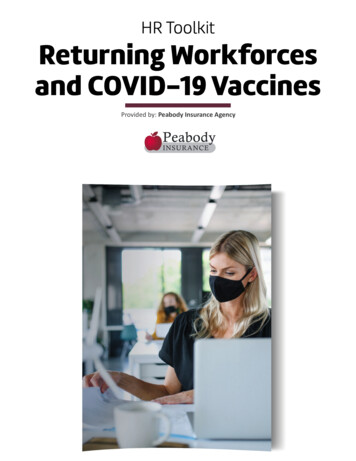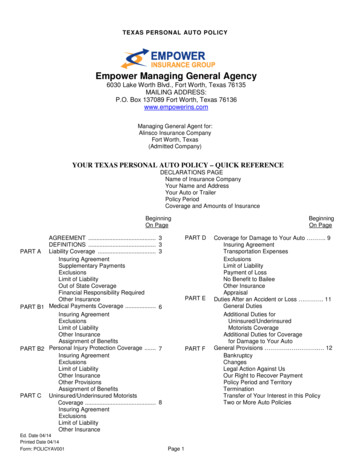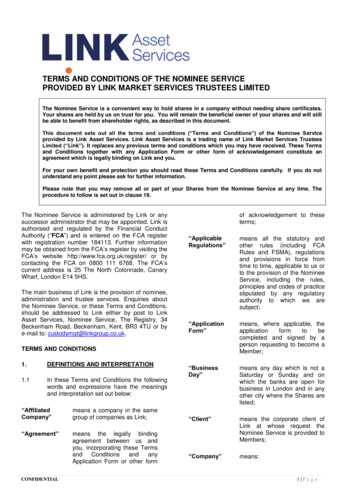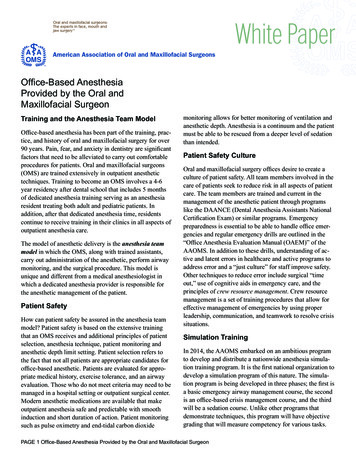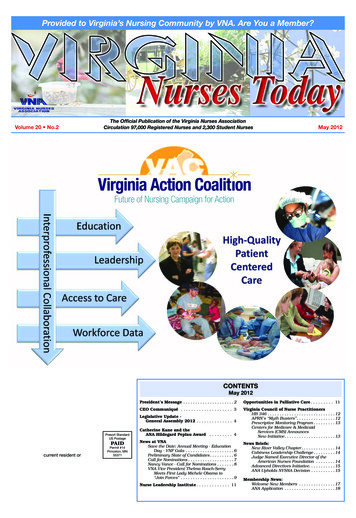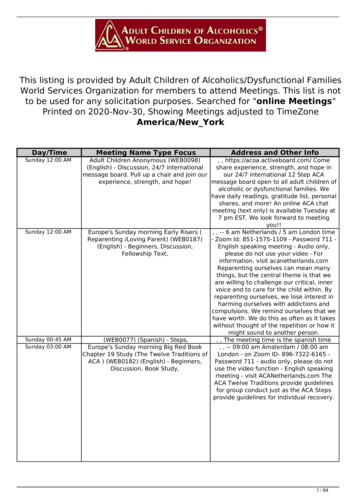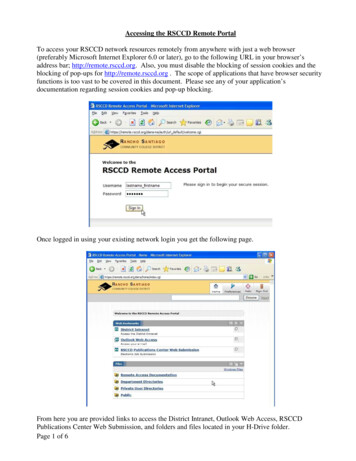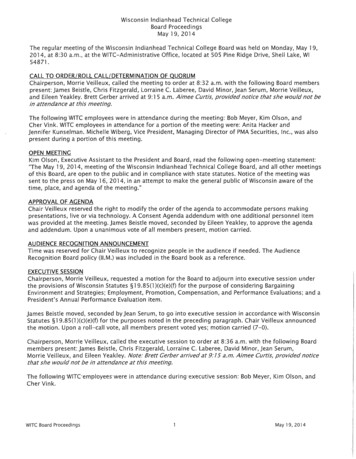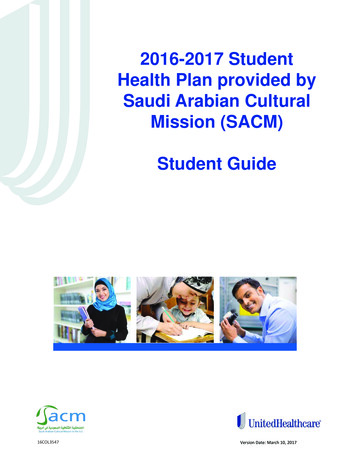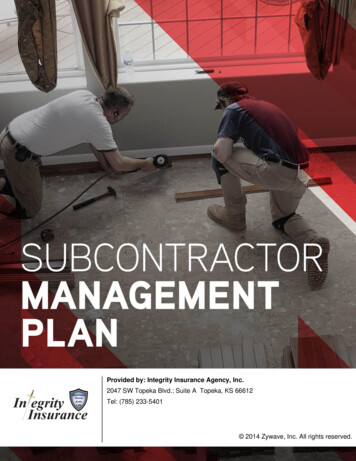
Transcription
Provided by: Integrity Insurance Agency, Inc.2047 SW Topeka Blvd.; Suite A Topeka, KS 66612Tel: (785) 233-54011 SUBCONTRACTOR MANAGEMENT PLAN 2014 Zywave, Inc. All rights reserved.
Table of ContentsIntroduction . 3Prequalification and Bidding Process . 4Insurance Considerations . 6Beginning Work . 9Work Site’s Written Safety Plan . 11Safety Training and Recordkeeping Policies . 13Safety Inspections. 15Work-in-progress and Post-project Reviews . 212 SUBCONTRACTOR MANAGEMENT PLAN
IntroductionA Subcontractor Management Plan (SMP) outlines the relationship between contractors while they areperforming work for a certain project, and it outlines the methods by which the primary contractor willensure the production of quality deliverables from each of its subcontractors and ensure the developmentof long-term business relationships between the companies.Please note that this plan contains key components that should be considered when drafting an SMP.This guide is not all-inclusive and certain areas may not apply to your contract. Also, include othercomponents or areas pertinent to your contract.Although the procurement person prepares the SMP, it is vital that the SMP contain the input of othermembers of the contract management team to ensure that existing issues, vulnerabilities and risks areadequately addressed. Consequently, the SMP draft should be routed for input through members of thecontract management team.This SMP provides guidance for subcontract management activities, including the following: Prequalification and bidding process Insurance considerations Beginning work Work site’s written safety plan Safety training and recordkeeping policies Safety inspections Work-in-progress and post-project reviews3 SUBCONTRACTOR MANAGEMENT PLAN
Prequalification and Bidding ProcessPrequalifying subcontractors is an important way to ensure the hiring of a subcontractor that has thenecessary experience and the ability to complete the job safely, on time and within the budget. While notmandatory, prequalifying a subcontractor helps minimize risk and increases the chance of the job beingdone right. Consider the following when going through the prequalification process. Gather the subcontractor’s qualifications, whether through a questionnaire, formal written request,qualification statement or other method. Examine the following information:oDoes the subcontractor have experience completing similar work?oDoes the subcontractor have the necessary resources (manpower, finances, availableequipment, insurance and surety bonding capacity, licensing, etc.) to complete the job?oDoes the subcontractor have a history of litigation or other legal problems?oDoes the subcontractor have any past OSHA or EPA violations?oDoes the subcontractor’s safety record prove that the job can be done in a safe manner?oDoes the subcontractor have any references from previous contracts? Were pastcustomers satisfied with the subcontractor’s work?o What is the subcontractor’s Experience Modification Rate (EMR)?Prequalification should let a potential bidder know exactly what to expect from project start tofinish. Giving a bidder every piece of relevant information, along with being available to answerany questions he or she might have, will make the process fair and objective. Not all subcontractors will qualify for the bid. To weed out bids that fall short of your standards,consider implementing minimum requirements for the subcontractor, such as making sure thesubcontractor:oHas not been nor is currently debarred by any federal, state or local government authorityin the past X yearsoHas not defaulted on any project in the past X yearsoHas not had any professional license revoked in the past X yearsoHas not committed a serious or willful OSHA, EPA or other federal or state safetyviolation in the past X yearsAfter a list is compiled of qualified bidders, bids can be submitted. Generally, qualified bidders with thelowest bid will be selected for the contract, although this is not always the case. The U.S. Office ofManagement and Budget has found that lowest-bid contracts do not always ensure that a project iscompleted on time within the stated budget. Lowest-bid contracts tend to have more change ordersthroughout the process, increasing the overall cost of the contract and often causing delays and brokendeadlines. Thorough examination of a subcontractor’s qualifications and the proceeding bid, if4 SUBCONTRACTOR MANAGEMENT PLAN
reasonable, should both be taken into consideration before selecting a subcontractor for the job.Prior to awarding the contract to a qualified bidder, the primary contractor or owner should document: The proposed project schedule that includes key milestones and a description of the technicalapproach to the project; The project management team that includes, at a minimum, the construction management, fieldsupervision and technical personnel. With the project management team list, resumes of thepeople listed may be included; A quality control plan that includes a copy and/or description of the quality control program to beused on the project and any implementing documents applicable to its program; and A cost control plan that includes a description of the cost control program being used for theproject.5 SUBCONTRACTOR MANAGEMENT PLAN
Insurance ConsiderationsCertificate of InsurancePrior to the beginning of the project, the subcontractor should provide two certificates of insurance to theprimary contractor showing that the subcontractor has coverage for him- or herself and his or heremployees, agents and subcontractors. The subcontractor’s insurance must provide adequate coveragefor any workers’ compensation obligations, employer’s liability and automobile liability. If any of thesepolicies are terminated, the subcontractor should provide certificates of insurance showing replacementcoverage. All coverage must be placed with insurance companies duly admitted in the state or in thedesired licensing jurisdiction in which the work is being done, and all coverage must be reasonablyacceptable to the primary contractor. All of the subcontractor’s insurance carriers must maintain an A.M.Best rating of “A-” or better.The certificate of insurance should provide that the insurer give the contractor a written notice ofcancellation and termination of the contractor’s coverage at least 30 days prior.Additional InsuredsThe subcontractor’s policy must name the contractor as an additional insured. Coverage must be affordedto the contractor as an additional insured whether or not a claim is in litigation. Additional insuredcoverage must apply as primary insurance with respect to any other insurance afforded to the owner andcontractor.Insurance Coverages Subcontractors Should PossessWorkers’ compensation The subcontractor should secure a workers’ compensation insurance policy. The workers’compensation policy must cover all of the subcontractor’s work and performance and providecoverage for all employees, executive officers, sole proprietors, and partners and members of alimited liability company, in the amounts required by all applicable laws. In addition, the subcontractor should secure an employers’ liability insurance policy (part II of thestandard workers’ compensation policy). This type of coverage covers the damages that becomedue in case of bodily injury, occupational sickness or disease or death of subcontractoremployees that are not covered by the workers’ compensation policy. If a subcontractor does not have his or her own work comp insurance, you may see your workcomp premium rise during an audit. This is why it is so important that the subcontractors you hireprovide proof of insurance before any work is done.Commercial general liability (CGL) Subcontractors should secure a CGL insurance policy to cover the damages that become due incase of bodily injury, property damage and personal or advertising injury arising out of or relatedto:6 SUBCONTRACTOR MANAGEMENT PLAN
oAll of the subcontractor’s operations and premises;oAll of the subcontractor’s products and completed operations;oAll liability or responsibility assumed by the subcontractor;oAll liability assumed in a business contract;oThe contractor as an additional insured; andoDefense expenses paid in addition to the policy limits.There should be no endorsement or modification of the CGL for risks arising from pollution,explosion, collapse, underground property damage or work performed by the subcontractor.Auto liability The subcontractor should secure an automobile liability insurance policy to cover the damagesthat become due in case of bodily injury, death of a person or property damage arising out ofownership, maintenance or use of any motor vehicle or trailer owned, hired, leased, used onbehalf of or borrowed by the subcontractor. The policy must also include coverage for anyequipment subject to motor vehicle laws, contractor and owner (if different than the contractor)and any subcontractor liability or responsibility.Umbrella or excess liability coverage The subcontractor should secure an umbrella liability insurance policy to cover the damages thatbecome due in case of bodily injury, property damage and personal and advertising injury, with atleast the same terms and conditions as the policies mentioned above.Completed Operations Liability and ObligationsEven quality workmanship is not immune to potential claims of property damage or bodily injury. Alloperations carry the risk that injury or damage may occur as a result of the work, leading to costlylawsuits. Considering the complicated mix of contractors and subcontractors that contributes to eachproject, who is liable for this risk?In insurance terms, “your work” as used in an insurance policy is a broadly defined term that includesoperations performed by the policyholder or on the policyholder’s behalf, including material, parts orequipment in connection with the operations. Operations or work performed on behalf of the policyholdermeans work done by a subcontractor is considered the contractor’s work. Therefore, faulty electrical workperformed by an electrician that causes a fire or other damage could be considered the contractor’sliability, but would be covered under a standard CGL policy.Because a contractor or other involved party could be held liable for defects in a subcontractor’s work,years after it has been completed, and filing the claim under the contractor’s CGL policy could cause thepremium to rise, many construction contracts require subcontractors to provide insurance coverage forclaims resulting from their completed work for a finite period of time, typically the one- to five-year range.Typical contracts also require that the subcontractor name the owner, the architect, the general contractor7 SUBCONTRACTOR MANAGEMENT PLAN
and other third parties as “additional insured” parties, entitled to coverage under the insuredsubcontractor’s CGL policy. Naming additional insured parties requires a separate endorsement to thatpolicy.This means that subcontractors can be held liable for claims of property damage or bodily injury resultingfrom a defect in a contractor’s work. It is also critical to maintain this coverage into the future; failure to doso could lead to a breach-of-contract lawsuit brought by the contractor or other party.It is important for subcontractors to understand this commitment when signing the contract—theinsurance commitment doesn’t end with the project. Further, in the event of a large claim, subcontractorscould be faced with a substantial increase in premiums on the policy.What can subcontractors do to reduce the risk of a claim being filed against them for a defect in theircompleted work? To avoid litigation, it is crucial to know local regulations and adequately documentproper performance. Subcontractors must know their company’s documentation practices relative to eachsubcontract, and carefully keep records of all processes.8 SUBCONTRACTOR MANAGEMENT PLAN
Beginning WorkAfter a subcontractor has been selected, each subcontractor should have a legally binding, writtencontract that defines the following items: The legal names of the parties involved in the contract The scope of the contracted work (contained in an attached statement of work (SOW)), whichshould include the following items:oEach subcontractor’s clearly defined responsibilities and authoritiesoEach subcontractor’s deliverables identified, and required content clearly specifiedoEach subcontractor’s clearly identified and described services that it is responsible forprovidingoSchedule and budget constraintsoEach subcontractor’s clearly defined requirements for quality, including the requirementto allow independent quality inspections of materials and processes oAppropriate terms and conditionsoAdequate facilities provided to meet the needs of the subcontractorsoThe primary contractor’s support in processing invoices and paymentsThe appropriate terms and conditions that will be imposed on both the primary contractor and thesubcontractor An acceptance processGeneral Subcontractor ManagementManaging various subcontractors and their teams can be a difficult task, but successful projects all tendto have the same characteristics: They all have clear and unambiguous subcontracts established that include an SOW. The efforts of all subcontractors are integrated into a cohesive project plan with all subcontractorsunderstanding where their efforts fit into the overall picture. The formal and informal interfaces between the primary contractor and the subcontractors, aswell as among the subcontractors, are documented. Before starting specific work, the subcontractors are granted authorization to proceed. Thisauthorization is given, in writing, via a Work Authorization form. A formal team building process is established and implemented.These practices all contribute to reducing the risk of misunderstandings or isolationism.The work of all subcontractors should be coordinated by the primary contractor to ensure that the efforts9 SUBCONTRACTOR MANAGEMENT PLAN
of all parties are integrated into a cohesive unit throughout the entire project process. A master scheduleshould be developed to establish schedule constraints and identify contractual and significant internalmilestones.Subcontractors should have a single point of contact with the primary contractor for contractual matters.On a day-to-day basis, all subcontractor personnel will be free to interact with any primary contractorpersonnel as needed.Safety Information ExchangeIn order to make the project go as smoothly as possible, there needs to be open lines of communicationbetween the subcontractor and primary contractor regarding proper safety procedures. The subcontractormust: Designate a safety representative to handle all safety and health issues during the job Provide proof of necessary safety training Perform a safety hazard assessment to address any problem areas before work begins Report all injuries, spills, property damage incidents and near misses Obtain phone numbers and directions for the nearest hospital, ambulance service and firedepartment, should an accident occur Know, follow and train his or her employees about the safety policy of the contracting company Obtain the Safety Data Sheets (SDS) of any chemicals used during the job Provide employees with proper identification Comply with all owner safety rulesPre-work MeetingsBefore work begins each day, subcontractors should hold a pre-work meeting to discuss the type of workto be performed. Safety should be the main focus of these meetings—the subcontractor and his or herteam should review specific safety considerations for the particular type of work to be accomplished.Workers should be encouraged to voice any safety concerns before an accident occurs. Subcontractorsshould secure all necessary permits (hot work, lockout/tagout, confined spaces, etc.) before work begins.10 S U B C O N T R A C T O R M A N A G E M E N T P L A N
Work Site’s Written Safety PlanAll subcontractors and their employees should abide by the site-specific rules and regulations that are setforth by the contracting company. The safety policy must be followed by all contractors, subcontractorsand their employees. Failure to comply could result in disciplinary action, up to and including contracttermination. The safety policy will generally contain the following:Introduction Lists the overall goal of the safety program and conveys the importance of following it while onthe job Encourages employees to work safely and report injuries or unsafe conditionsManagement Commitment Lists the company’s policies and philosophies and makes employees aware of management’scommitment to safety May include a mission statement, outlining the company’s goals for the safety programResponsibilities for Different Parties Explains what everyone’s responsibilities are in executing the safety program, includingmanagement, supervisors and employees Management’s responsibilities may include ensuring that the safety program is enforced andcorrecting any problems brought to its attention by supervisors or employees on the work site. Supervisors may be responsible for taking action to correct safety problems, providing personalprotective equipment (PPE) to all employees, disciplining workers and investigating any accidentsor injuries. Employees may be responsible for reporting accidents and injuries, reporting unsafe conditions,attending any safety training and obeying all safety and health regulations.Safety Rules and Regulations Outlines specific (OSHA, EPA, DOL, etc.) rules and regulations that must be followed at all timeson the joboFor example, OSHA regulations for lockout/tagout procedures (29 CFR 1910.147) maybe spelled out for workers. May include the work site’s Hazard Communication ProgramDisciplinary Policy Explains what may happen if workers break rules or regulations. Disciplinary action may rangefrom a verbal warning to dismissal from the job.Accident and Injury Reporting and Investigation Procedures11 S U B C O N T R A C T O R M A N A G E M E N T P L A N
Explains when and how to report an accident or injury while at the work site Outlines an accident investigator’s process for determining why an accident happened and whatcan be done to prevent similar accidents from happening in the futureSafety Training Requirements Describes training requirements for all employees working on the job Training topics may include the following: Aerial lift safety Crane, hoist and rigging safety Excavation and trenching safety Fall protection Fire extinguisher operation Hearing protection Heat illness prevention Housekeeping Ladder safety Lockout/tagout procedures Powered industrial truck safety Respiratory protectionEmergency Response Plan Outlines the procedure for responding to an emergency due to a fire, chemical spill, naturaldisaster, injury, etc.Workplace Violence Prevention Lists the risks and warning signs of workplace violence and offers ways to reduce the likelihood ofviolence on the jobSubcontractors should also submit their site-specific safety plans before work begins. These plans shouldinclude job-specific safety requirements, roles and responsibilities of the
A Subcontractor Management Plan (SMP) outlines the relationship between contractors while they are performing work for a certain project, and it outlines the methods by which the primary contractor will ensure the production of quality deliverables f
